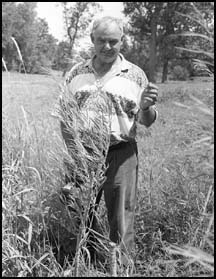 A year after its completion, a bio-engineering project on the Gerald Kennedy farm is being considered a success by Kennedy, project designer Pat Corrigan, Land Care Environmental Services of Sauk Rapids, and others involved in its completion.
A year after its completion, a bio-engineering project on the Gerald Kennedy farm is being considered a success by Kennedy, project designer Pat Corrigan, Land Care Environmental Services of Sauk Rapids, and others involved in its completion.The project, a first of its kind in the area, involved planting willow shoots on the banks of the North Fork Crow River east of the Lake Street bridge in Paynesville.
Corrigan said bio-engineering is gaining popularity around the state as it helps control erosion on rivers and streams.
High water levels, fast moving river currents, and cattle walking through the river contributed to the erosion on a section of the North Fork Crow River which runs through the Kennedy property. Kennedy purchased the property about four years ago.
After purchasing the property, Kennedy had put out feelers, seeking help in preventing the river banks from eroding and the river from getting wider and wider. "I had lost several trees to the erosion of the river," Kennedy said.
The stretch of river through Kennedy's farm was perfect for the bio-engineering project, Corrigan said.
Pictured at right is Kennedy inspecting some willow trees on the river bank.
After reshaping the river bank and building a bream on the south side, workers placed two fiber logs in different locations along the south shoreline of the North Fork Crow River. The logs helped prevent the river from flowing over its banks and washing out the willow shoots.
The area between the fiber logs was protected with 200 cubic yards of rip rap ranging from eight inches in diameter to 36 inches in diameter.
Three rows of dormant willow shoots were planted along the river banks. "It looked like they planted sticks in the ground," Kennedy said.
The entire project involved restoring about 500 feet of the river bank along Kennedy's property. Two different segments (over 100 feet) of the river bank were planted with the willow shoots.
As part of the project, existing debris was pulled from the river. "It was a mess with junk, rocks, brush, and old barbed wire in the river and on the river bank," Kennedy said. "I feel the entire project was worthwhile."
Another part of the project involved excavating a part of the river. They removed 15 to 20 feet of the riverbed and replaced it with small rocks. This provides Kennedy's horses a place to cross the river without disturbing the river bottom.
"My horses wouldn't cross the river because the river bottom was so soft," Kennedy added.
This summer, project planners have gone back to the Kennedy farm to see how the shoots have grown. "The majority of the shoots have sprouted new life. Corrigan said the first year is an establishment year for the willow shoots. It will take two to three years for the willow shoots to form a thick growth and appear like a natural willow hedge. The hedge will help protect the river banks from erosion.
"The area is wet enough that the shoots should grow on their own and not need any watering during a dry period," Corrigan added.
"We did not expect 100 percent survival the first year," Corrigan said. "But we are pleased with the results at Kennedys. The shoots were planted close enough together to someday produce a thick bushy area."
"We hope to be able to use the bio-engineering plans more often in future projects. It is a lot cheaper than hauling rip-rap (rocks) along river or lake edges," Corrigan added.
Since the completion of the project, Kennedy feels an additional six large trees were saved from collapsing into the river due to erosion.
Kennedy shared the cost of the project with the Minnesota Pollution Control Agency, Funds were also available through the North Fork Crow River Watershed District, Clean Water Partnership Fund, and federal funds.v Corrigan would like to do similar projects along Rice Lake or other areas of the North Fork Crow River. "Aquascaping is a natural way to restore nature's landscaping," he said.v The project are part of the Clean Water Partnership between the Rice Lake Association and the Koronis Lake Association. Anyone wanting more information can contact Corrigan at 320-255-5502.